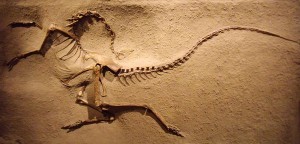The famous feathered dinosaur archaeopteryx seems to have had a penchant for fossilizing in painful positions, with its head cranked backward at a severe angle. The contorted posture is so common in dinosaur fossils that it has its own name: opisthotonus, from the Greek “tonos,” meaning tightening, and “opistho,” behind.
Since the 1920s, paleontologists have debated how these dinosaurs came to have such grotesque final resting positions. Some theorized that water currents moved the bones into formation, or that the muscle contractions of rigor mortis pulled the head backward. Others thought the animals must have died in pain.
New research proposes a simpler explanation.

TWISTED Dinosaur fossils are often found with sharply curved necks, but that doesn't mean that they died in agony.
In a paper published last month in the journal Palaeobiodiversity and Palaeoenvironments, Achim G. Reisdorf of the University of Basel in Switzerland writes that the trouble with the death-throe hypothesis is that carcasses are flexible. To fossilize in the traumatic death position, a carcass would have to be quickly buried in the exact spot where it died, without any transportation.
But that is unlikely, Mr. Reisdorf wrote. Many of the dinosaurs found in opisthotonic posture are land animals that fell into sediment at the bottom of bodies of water, and probably had to settle before reaching their final resting place.
Mr. Reisdorf thought water might be the key. So he and a colleague, Dr. Michael Wuttke, decided to try some kitchen science. They bought fresh chicken necks from a butcher and plunged them into water buckets.
Immediately, the necks bent backward by 90 degrees. After three months and significant rotting, they had twisted further backward — to 140 degrees.
These results were verified at Brigham Young University by a paleontologist, Brooks B. Britt, and an undergraduate student, Alicia Cutler.
“When you hold a carcass in your hand, it’s like a limp rag, you can move it anywhere,” Dr. Britt said. “But as soon as we put the first dead chicken in the water, we realized, ‘Holy smokes, this is amazing.’ The head immediately curved backwards.”
To test whether muscle contractions caused the spasms, both groups of researchers removed the skin and muscle from the birds, and got the same result. Only by cutting the ligaments between vertebrae could they prevent the necks from bending backward in water.
The teams independently concluded that the ligaments in chicken necks were like rubber bands — bendable, but contracted by default to hold the bird’s head upright against gravity. In the dead chicken, those ligaments still want to return to their natural, unstretched position, but the dead weight of the bird fights against it. In water, however, buoyancy and lack of friction allow the ligaments to contract into their natural shape, cranking the neck backward as they go.
The observations have been replicated in other bird species, in saltwater and fresh water, and at various depths. Because birds are living dinosaurs, the researchers think the same phenomenon may have caused opisthotonic posture in nonavian dinosaurs as well.
Kevin Padian, a paleontologist at the University of California, Berkeley, is not entirely convinced. Because similar contortions of the spine and neck occur when modern animals experience trauma, he has argued that a fossil’s opisthotonic posture could indicate that the animal died of suffocation, starvation, poisoning or other brain injuries.
Mr. Reisdorf “may be onto something, but it remains to be seen,” Dr. Padian said. The new observations don’t explain the opisthotonic fossils found in dry, non-aqueous sediments. Nor do they explain how mammals — which have a different ligament anatomy — also fossilized with these postures.
“I don’t think the two theories are mutually exclusive,” he continued. “The question is, how do you tell what’s really going on?” Like a 150-million-year-old crime scene, ancient fossils offer few clues to help paleontologists reconstruct the past.
But Mr. Reisdorf and Dr. Britt say their research reprieves most of these dinosaurs from the agonizing deaths that had been proposed for them. “A longstanding debate has been solved,” Dr. Britt said, “and it turns out to be pretty doggone simple: Just add water.”



 April 6th, 2012
April 6th, 2012  riffin
riffin  Posted in
Posted in 